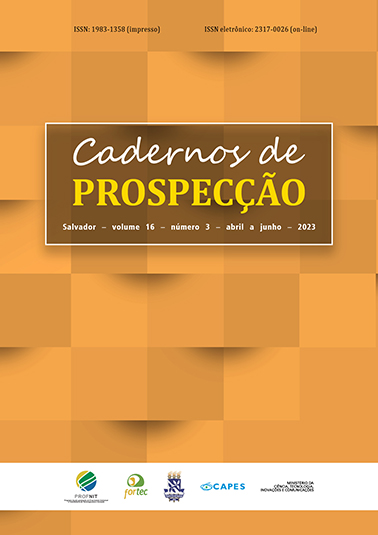Technological Mapping of Patents About Spidroin: an overview of the spider silk market
DOI:
https://doi.org/10.9771/cp.v16i3.51560Keywords:
Spidroin, Biotechnology, SilkAbstract
The interest in the development of technologies involving spidroin, the main component of spider silk, has grown exponentially since the 2000s. This growth is based on the exceptional properties of this biomaterial, such as extreme resistance, malleability, biocompatibility, and biodegradability. The present work aimed to investigate the technological development of the spider silk market. For this, we performed searches of patents and scientific articles related to spidroin. The temporal evolution, the main players in this sector and the main applications of spidroin-based products are discussed. The results suggest a significant growth in the use of biosynthetic spidroin in recent decades, especially in the textile and biomedical markets, driven by technological advances that allowed its large-scale production. Japan and China are the main holders of this knowledge. These countries emerged with great predominance on the world stage since 2015 and are currently at the forefront of this technological race.
Downloads
References
AGLIETTA, M.; BAI, G. China’s 13th Five-Year Plan. In Pursuit of a “Moderately Prosperous Society”. CEPII Policy Brief, [s.l.], n. 12, 2016.
BOLT THREADS. 2021. Disponível em: https://boltthreads.com/. Acesso em: 12 nov. 2021.
BREWED PROTEIN. Spiber Inc. 2021. Disponível em: https://www.spiber.incinc/en/brewedprotein/. Acesso em: 11 nov. 2021.
DAIHA, K. G. et al. Are Lipases Still Important Biocatalysts? A Study of Scientific Publications and Patents for Technological Forecasting. PLoS ONE, [s.l.], v. 10, n. 6, e0131624, 2015. DOI: 10.1371/journal.pone.0131624.
DEBABOV, V.; BOGUSH, V. G. Recombinant Spidroins as the Basis for New Materials. ACS Biomaterials Science & Engineering, [s.l.], v. 6, n. 7, p. 3.745-3.761, 2020. DOI: 10.1021/acsbiomaterials.0c00109.
FERNÁNDEZ, C. R. Meet the German Biotech Behind Adidas’ Biodegradable Shoes. Labiotech, [s.l.], 2018. Disponível em: https://www.labiotech.eu/interview/amsilk-adidas-biodegradable-shoes/. Acesso em: 16 nov. 2021.
GATESY, J. et al. Extreme Diversity, Conservation and Convergence of Spider Silk Fibroin Sequences. Science, [s.l.], v. 29, n. 5.513, p. 2.603-2.605, 2001. DOI: 10.1126/science.1057561.
HEIM, M.; KEERL, D.; SCHEIBEL, T. Spider Silk: From Soluble Protein to Extraordinary Fiber. Angewandt Chemie, [s.l.], v. 48, n. 20, p. 3.584-3.596, 2009. DOI: 10.1002/anie.200803341.
HESS, K.; KELLEY, B. Spider Silk Covered Stent. WO0138373A1. Depósito em 17 de novembro de 2000.
HIRATUKA, C. Changes in the Chinese Development Strategy after the Global Crisis and its Impact in Latin America. Revista de Economia Contemporânea, [s.l.], v. 22, n. 1, p. 1-25, 2018. DOI: https://doi.org/10.1590/198055272214.
KARATZAS, C. N. Surgical Sutures Containing Spider Silk. CA2398635A1. Depósito em 02 de fevereiro de 2001.
LIEBMANN, B. et al. Anti-Dandruff Compositions Containing Peptides. KR101417202B1. Depósito em 19 de dezembro de 2008.
LOMBARDI, S. J.; KAPLAN, D. L. Recombinant Spider Silk Proteins Through Genetic Engineering. WO9116351A1. Depósito em 29 de março de 1991.
MALAY, A. D. et al. Spider Silk Self-Assembly via Modular Liquid-Liquid Phase Separation and Nanofibrillation. Science Advances, [s.l.], v. 6, n. 45, p. 6, 2020. DOI: 10.1126/sciadv.abb6030.
MARELLI, B. et al. Silk Fibroin as Edible Coating for Perishable Food Preservation. Scientific Reports, [s.l.], v. 6, n. 25.263, 2016. DOI: 10.1038/srep25263.
MCCALLUM, J. E. Military Medicine: From Ancient Times to the 21st Century. ABC-CLIO, [s.l.], p. 272, 2008.
PTOCK, A. et al. Use of Protein Microbeads in Cosmetics. CA2638870A1. Depósito em 19 de janeiro de 2007.
RECH, E. L. F. et al. Proteins from the Webs of Nephilengys cruentata, Avicularia juruensis and Parawixia bistriata Spiders. WO2008113145A1. Depósito em 13 de março de 2008.
SCHEIBEL, T. Spider Silks: Recombinant Synthesis, Assembly, Spinning, and Engineering of Synthetic Proteins. Microbial Cell Factories, [s.l.], v. 3, n. 1, p. 14, 2004. DOI: 10.1186/1475-2859-3-14.
SILL, T. J.; VON RECUM, H. A. Electrospinning: Applications in Drug Delivery and Tissue Engineering. Biomaterials, [s.l.], v. 29, n. 13, p. 1.989-2.006, 2008. DOI: 10.1016/j.biomaterials.2008.01.011.
SPIBER TECHNOLOGIES AB. 2021. Disponível em: https://spiber.se/. Acesso em: 12 nov. 2021.
TSUNEDA, S. S. et al. Monitoramento Tecnológico Relacionado a Genes e Proteínas da Teia de Aranhas no Incremento Estrutural de Materiais. Cadernos de Prospecção, Salvador, v. 8, n. 4, p. 615-626, 2015. DOI: 10.9771/s.cprosp.2015.008.079.
VOLLRATH, F. et al. Local Tolerance to Spider Silks and Protein Polymers in vivo. In Vivo, [s.l.], v. 16, n. 4, p. 229-234, 2002.
Downloads
Published
How to Cite
Issue
Section
License
Copyright (c) 2023 Cadernos de Prospecção

This work is licensed under a Creative Commons Attribution-NonCommercial 4.0 International License.
O autor declara que: - Todos os autores foram nomeados. - Está submetendo o manuscrito com o consentimento dos outros autores. - Caso o trabalho submetido tiver sido contratado por algum empregador, tem o consentimento do referido empregador. - Os autores estão cientes de que é condição de publicação que os manuscritos submetidos a esta revista não tenham sido publicados anteriormente e não sejam submetidos ou publicados simultaneamente em outro periódico sem prévia autorização do Conselho Editorial. - Os autores concordam que o seu artigo ou parte dele possa ser distribuído e/ou reproduzido por qualquer forma, incluindo traduções, desde que sejam citados de modo completo esta revista e os autores do manuscrito. - Revista Cadernos de Prospecção está licenciado com uma Licença Creative Commons Attribution 4.0. Esta licença permite que outros remixem, adaptem e criem a partir do seu trabalho para fins não comerciais, e embora os novos trabalhos tenham de lhe atribuir o devido crédito e não possam ser usados para fins comerciais, os usuários não têm de licenciar esses trabalhos derivados sob os mesmos termos.
Este obra está licenciado com uma Licença Creative Commons Atribuição 4.0 Internacional.





